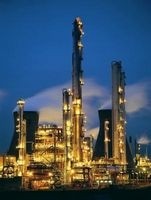Safety At Chemical Plants

afety at any industrial site is a concern and it's even more intense at chemical plants due to the increased potential for accidents and injury. Several federal agencies have regulations in place to cover a number of chemical plant safety issues such as chemical releases and worker protection. Homeland Security also has instituted regulations regarding the protection of volatile substances or vulnerable sites. Ultimately, companies are on the front line for ensuring the safety of their workers and the public.
Process Safety Management
Process safety management is the plan required of chemical plants to assure every step of the production process is safe. When any process takes place involving a chemical, each step, the equipment, employee training and the process itself is to be planned, inspected, audited and monitored. This is a self-regulating program, but all steps are reported to the Occupational Safety and Health Administration. It's in place to ensure worker safety and the reduction of any environmental hazards or release that can be dangerous to the public. The program is time and training intensive, but when dealing with hazardous chemicals, it's necessary.
OSHA
The Occupational Health and Safety Administration is primarily responsible for regulating and enforcing the laws and mandates in the chemical industry. It can bring action against chemical plants not in compliance with the rules, and can inspect and audit facilities to be sure the proper safety procedures are being followed. Typically, it's either when a report is made indicating lack of safety adherence or an accident has already occurred that OSHA steps in to determine if a facility is in compliance.
Homeland Security
Due to the vulnerability of chemical plants in a terrorist attack or the use of their products against the public, Homeland Security initiated heavy enforcement of regulations for security at chemical plants. Specific safety and protection regulations and protocols are mandated and companies not in compliance can be fined up to $25,000 per day. The regulations are a benefit to both the public and the companies themselves, even if putting them in place has cost or time factors involved, since the damage from a chemical attack would be catastrophic.
Procedures and Protocol
The bulk of safe practice implementation lies with companies or facilities themselves. Operators, managers and owners and those onsite have to comply with regulations and be interested in having safe facilities. The financial bottom line is often a tempting reason to cut corners or reduce the time spent on safety, but a vested interest in completing inspections, following up on any incidents, training, and safety management will save money in the long run. Accidents are costly and cause intense scrutiny, inspections and even complete shutdown if the proper procedures haven't been followed. The adage better safe than sorry certainly applies to self-regulation at chemical plants.
Process Safety Management
Process safety management is the plan required of chemical plants to assure every step of the production process is safe. When any process takes place involving a chemical, each step, the equipment, employee training and the process itself is to be planned, inspected, audited and monitored. This is a self-regulating program, but all steps are reported to the Occupational Safety and Health Administration. It's in place to ensure worker safety and the reduction of any environmental hazards or release that can be dangerous to the public. The program is time and training intensive, but when dealing with hazardous chemicals, it's necessary.
OSHA
The Occupational Health and Safety Administration is primarily responsible for regulating and enforcing the laws and mandates in the chemical industry. It can bring action against chemical plants not in compliance with the rules, and can inspect and audit facilities to be sure the proper safety procedures are being followed. Typically, it's either when a report is made indicating lack of safety adherence or an accident has already occurred that OSHA steps in to determine if a facility is in compliance.
Homeland Security
Due to the vulnerability of chemical plants in a terrorist attack or the use of their products against the public, Homeland Security initiated heavy enforcement of regulations for security at chemical plants. Specific safety and protection regulations and protocols are mandated and companies not in compliance can be fined up to $25,000 per day. The regulations are a benefit to both the public and the companies themselves, even if putting them in place has cost or time factors involved, since the damage from a chemical attack would be catastrophic.
Procedures and Protocol
The bulk of safe practice implementation lies with companies or facilities themselves. Operators, managers and owners and those onsite have to comply with regulations and be interested in having safe facilities. The financial bottom line is often a tempting reason to cut corners or reduce the time spent on safety, but a vested interest in completing inspections, following up on any incidents, training, and safety management will save money in the long run. Accidents are costly and cause intense scrutiny, inspections and even complete shutdown if the proper procedures haven't been followed. The adage better safe than sorry certainly applies to self-regulation at chemical plants.
- cq02c443495197bc322d0bcddbd9a89ccb.jpg